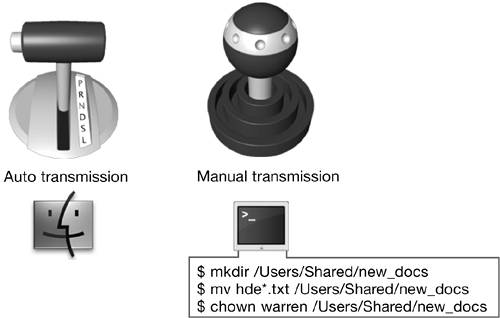Lesson 7. Command-Line Interface
|
Time
|
This lesson takes approximately 1 hour to
complete.
|
|
Goals
|
Identify reasons to use a command-line interface
and ways to access the command-line interface
Describe the syntax of commands entered at the
command line
Use the online manual to determine the syntax
and sample usage for a command
Run commands to view hidden files and folders
and to manipulate files and file attributes
Run commands to find files, manage processes,
monitor usage, and manage disks and volumes
Exchange data between the Finder and the command
line
|
Mac OS X is designed to
give users all the power of an industry-standard UNIX-based
operating system without having to know anything about BSD
(Berkeley Software Distribution) tools. From an administrator and
technical coordinator's perspective, however, you may find it
convenient to use a command-line interface to accomplish certain
administrative or troubleshooting tasks. Using the command-line
interface is optional, but for the purposes of obtaining Apple Help
Desk Essentials certification, it is necessary to understand the
basics of when, where, and how to use these tools.
Sometimes referred to in UNIX environments as a
shell, a command-line interface
executes commands entered as text rather than from a menu selection
or mouse click. The shell is the traditional interface to a UNIX
system, and many features of Mac OS X can be accessed only as
commands on the command line.
When you are shopping
for a new car, one of the decisions you have to make is whether you
want an automatic or manual transmission. Both types of
transmission have advantages and disadvantages. Ultimately, your
needs and preferences determine which you select.

Like selecting a transmission, the decision to
use the graphical or the command-line interface depends upon your
needs and preferences. Native Mac OS X applications, such as the
Finder, simplify your computer experience, handling many tasks
automatically. The command line allows you a greater degree of
manual control and configuration of your computer. In Mac OS X,
unlike a car, you don't have to chooseyou have both interfaces to
use whenever you need them.
TIP
As you become more comfortable with the
command-line interface, you will use it more frequently for
configuration and troubleshooting. However, when assisting others
with troubleshooting, you should use the graphical utilities
whenever possible; in these circumstances use the command-line only
when absolutely necessary.
|